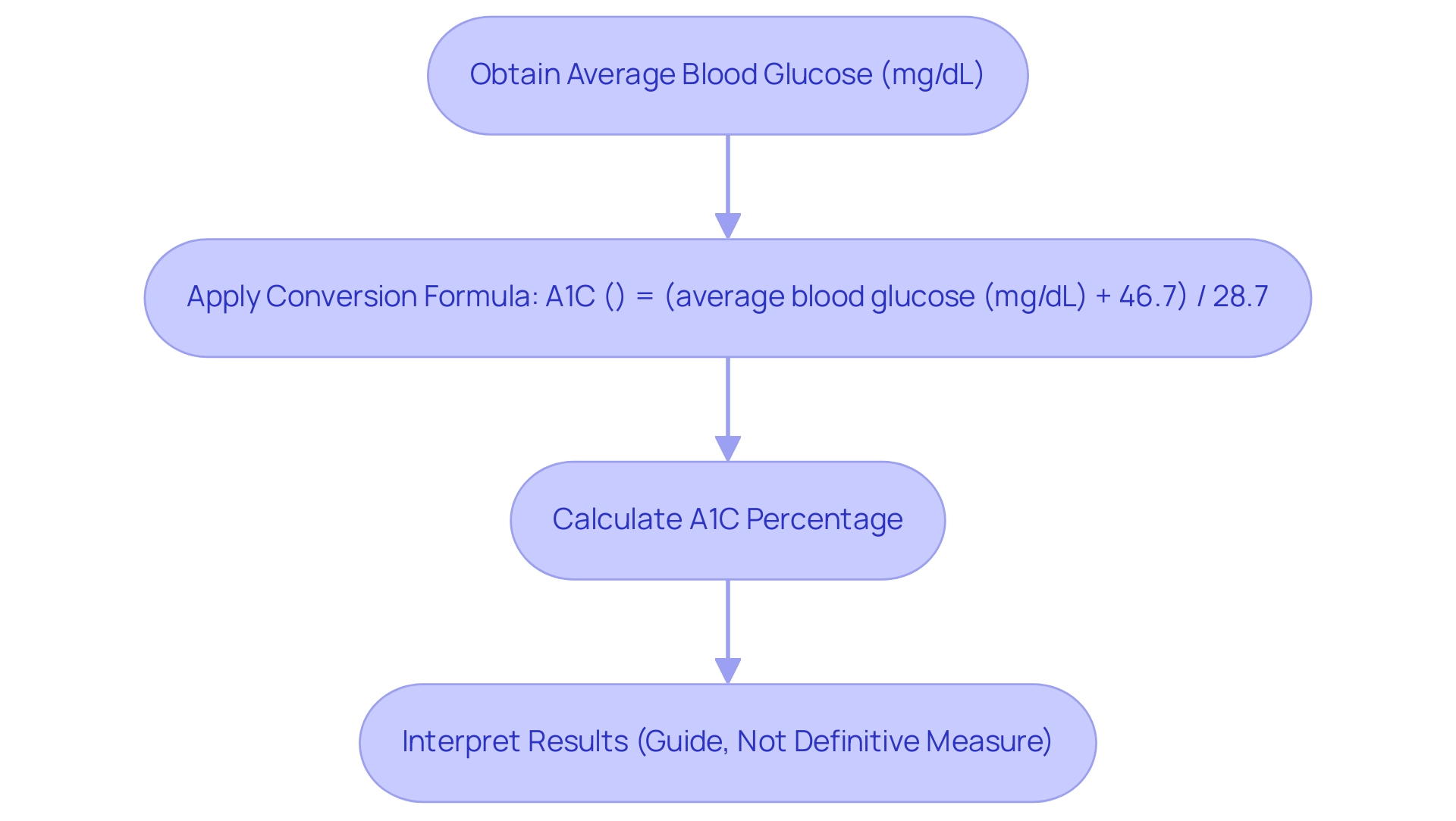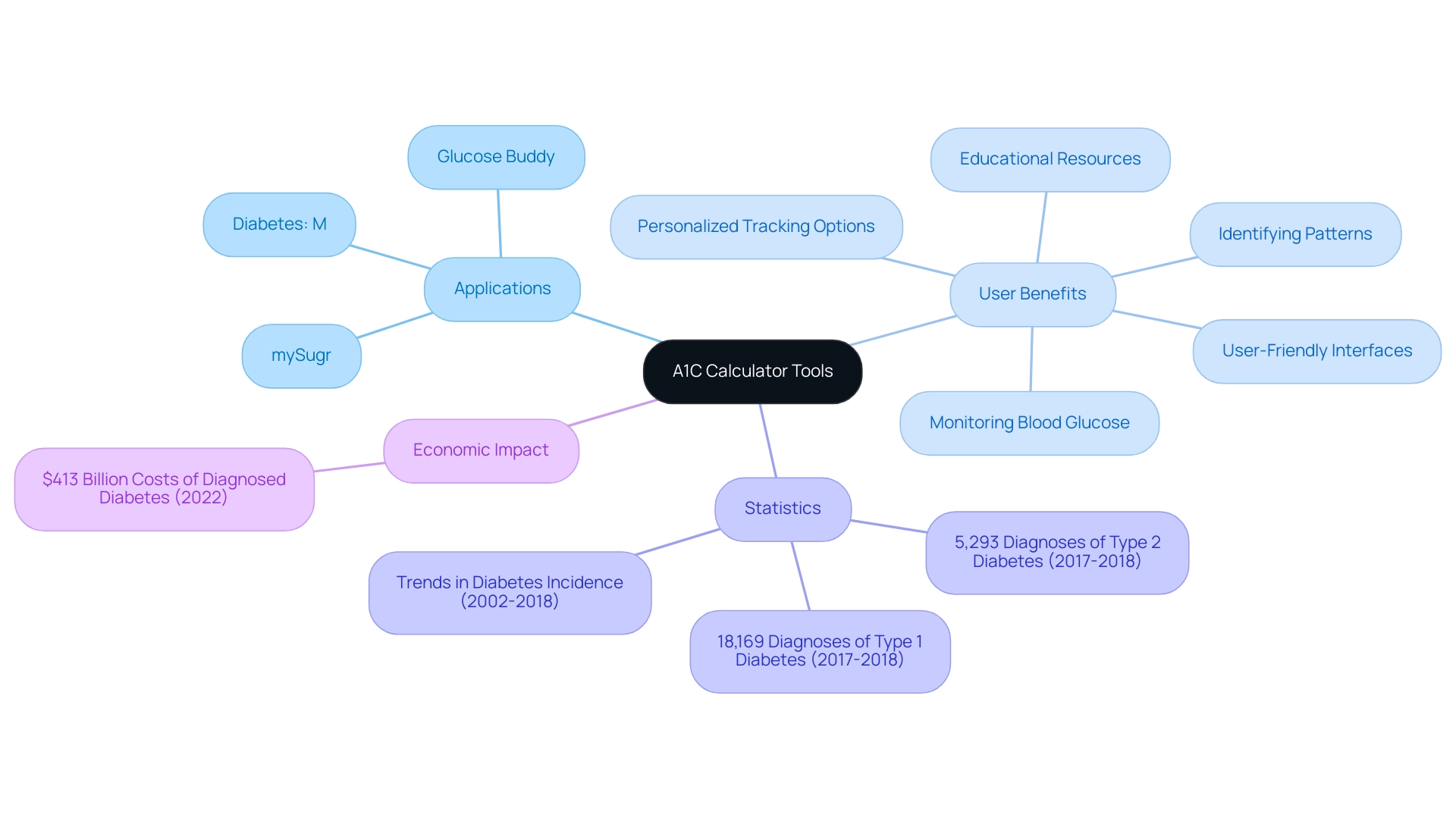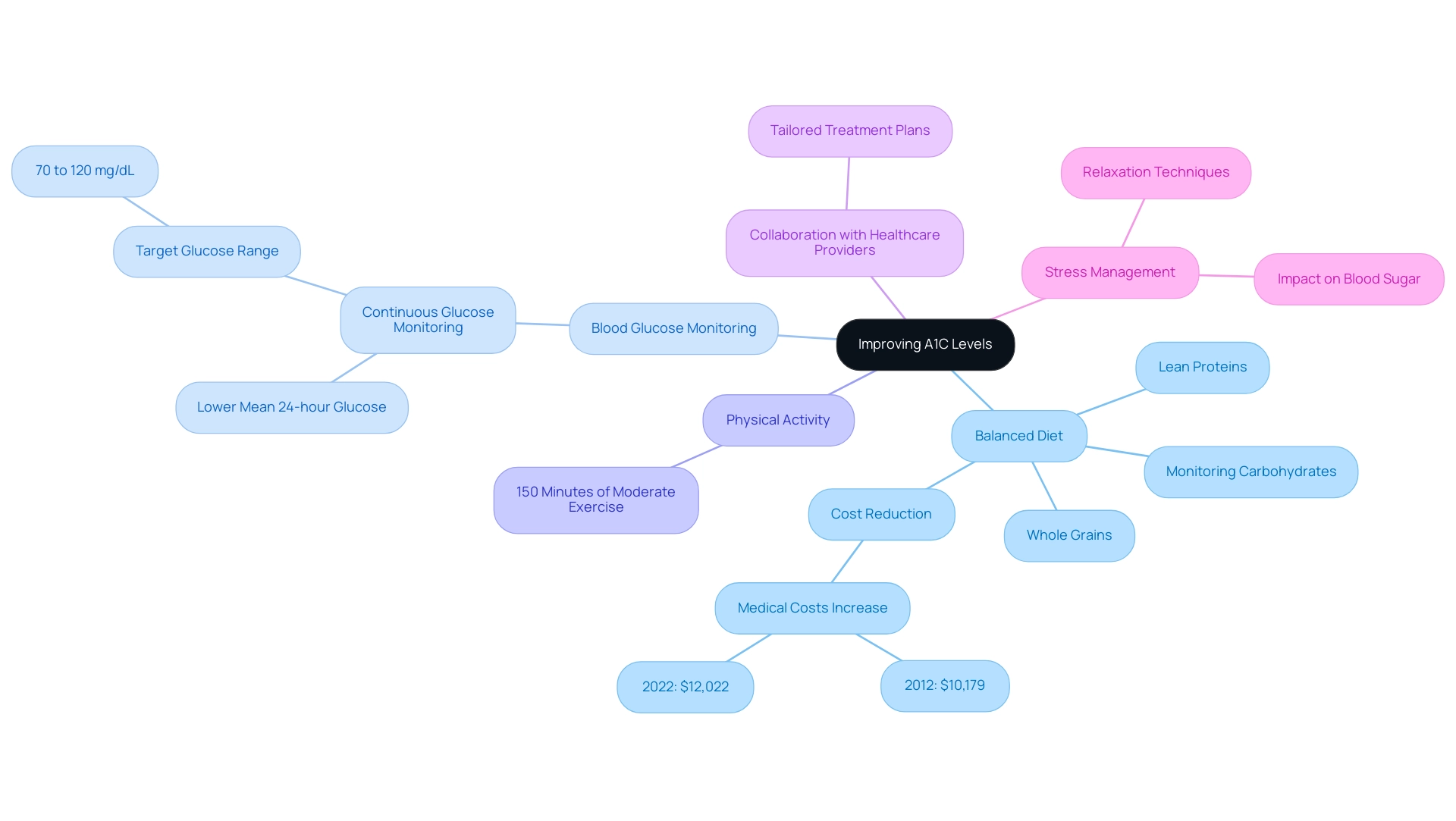Overview
The article titled "Understanding A1C Calculator Converters: An In-Depth Tutorial" focuses on explaining how A1C calculators work and their significance in diabetes management. It details the conversion formula for translating average blood glucose levels into A1C percentages, emphasizing that these tools provide valuable insights for individuals managing their condition, and highlights the importance of regular monitoring to maintain optimal health outcomes.
Introduction
The A1C test, a cornerstone in diabetes management, provides essential insights into blood glucose control over the past two to three months. By measuring glycated hemoglobin levels, this test categorizes individuals into various health statuses, from normal to diabetic, highlighting the urgent need for regular monitoring.
With nearly half of diagnosed adults exhibiting concerning A1C values, understanding this test's implications is crucial for effective diabetes management. As T2DSolutions emerges as a vital resource for those navigating Type 2 and Type 3 diabetes, it offers a wealth of tools and educational materials designed to empower patients in their health journeys.
This article delves into the significance of the A1C test, the functionality of A1C calculators, and practical strategies for improving A1C levels, providing a comprehensive overview for individuals seeking to enhance their understanding and management of diabetes.
Understanding the A1C Test: What It Measures and Its Importance
The A1C test, officially referred to as the glycated hemoglobin test, functions as an essential instrument in managing blood sugar by assessing the average glucose concentrations over the last two to three months. This test produces a percentage that shows how effectively blood sugar concentrations have been managed during this timeframe. Specifically, an A1C measurement below 5.7% is classified as normal, while readings ranging from 5.7% to 6.4% suggest prediabetes, and those at 6.5% or higher indicate a diagnosis of a blood sugar condition.
Given the concerning statistic that among adults with diagnosed hyperglycemia, 47.4% exhibit A1C values of 7.0% or higher—indicating inadequate blood sugar management—it becomes evident that regular monitoring of A1C readings is paramount. This practice not only aids in evaluating the effectiveness of management strategies for this condition but also informs necessary adjustments to treatment plans. Moreover, the occurrence of undetected blood sugar disorders is significant, with rates of:
- 1.6% in underweight or normal weight adults
- 2.8% in those who are overweight
- 7.9% in adults with obesity
This emphasizes the importance of tracking A1C values across various demographics.
Recent statistics from the National Center for Health Statistics reveal that the prevalence of diagnosed health issues related to blood sugar decreases with higher education levels, from 14.6% in adults with a high school degree or less to 7.3% in those with a bachelor’s degree or more. Additionally, the occurrence of type 1 and type 2 conditions has significantly increased among children and adolescents, with:
- 18,169 diagnosed with type 1
- 5,293 with type 2 during 2017-2018
This emphasizes the growing concern of these health issues across different age groups. As T2DSolutions launches as a comprehensive resource hub for Type 2 and Type 3 Diabetes education, it offers various tools, including an A1C calculator converter, educational materials, and community support programs.
Recent studies underscore the importance of interprofessional collaboration in interpreting A1C results, thereby enhancing patient outcomes and overall glycemic control. Through T2DSolutions, newly diagnosed patients can access essential information and support customized to their needs, reinforcing our dedication to empowering condition oversight through education and community involvement.

How A1C Calculators Work: Converting Blood Glucose to A1C
at&t Solutions, we are dedicated to supporting individuals recently diagnosed with Type 2 and Type 3 conditions. As part of our mission to empower our community, we are excited to introduce our comprehensive A1C calculator converter along with blood sugar calculators. These tools are created to offer useful insights into glucose control by estimating A1C percentages based on average blood sugar readings measured in mg/dL.
Utilizing the widely accepted conversion formula:
A1C (%) = (average blood glucose (mg/dL) + 46.7) / 28.7
users can quickly gauge their A1C levels with an A1C calculator converter without needing laboratory testing. While these calculators offer convenience for self-assessment, it’s important to remember that they yield estimates and should be viewed as guides rather than definitive measurements. The reliability of these calculators has been validated, as evidenced by the ease of use reported by lay users of the A1CNow SELFCHECK, whose accurate A1C measurements are comparable to those performed by healthcare professionals.
Sample bias was determined following CLSI guidelines at 6%, 8%, and 10% A1C, highlighting the significance of precision in blood sugar control. At T2DSolutions, we emphasize understanding how A1C calculator converter translates blood glucose to A1C, which is critical for effective management, particularly in light of findings from the HbA1c Analysis for Glycemic Estimation study that highlight the influence of non-glycemic factors on estimation accuracy. We are dedicated to offering resources like these calculators to empower individuals in their health journey and improve their understanding of managing their well-being.

Exploring A1C Calculator Tools: Apps and Online Resources
As we launch T2DSolutions, we are committed to providing a comprehensive resource hub for newly diagnosed patients managing Type 2 and Type 3 diabetes. A variety of A1C calculator converter tools will be made available, catering to both mobile app users and those who prefer online resources. Notable applications such as mySugr, Glucose Buddy, and Diabetes: M empower users to monitor their blood glucose readings over time, offering valuable insights into their health trends.
These tools not only facilitate the monitoring of A1C levels but also function as an A1C calculator converter, enabling individuals to identify patterns and make informed decisions regarding their treatment plans. Each calculator will include user-friendly interfaces, personalized tracking options, and educational resources to improve understanding of blood sugar control. The increasing occurrence of this condition—evidenced by the 5,293 diagnoses of Type 2 among children and adolescents in 2017-2018—highlights the urgent need for effective treatment solutions.
Additionally, the total direct and indirect estimated costs of diagnosed sugar-related conditions in the United States reached $413 billion in 2022, highlighting the economic impact and importance of tools such as the A1C calculator converter. The case study titled 'Trends in Type 1 and Type 2 Diabetes in Youth (2002-2018)' reveals a significant rise in incidence among youth, reinforcing the urgency for effective management solutions. Furthermore, as developer Feizan Ulhaq noted, the app’s privacy practices may include handling of data as described below, addressing potential concerns users may have about data handling.
By utilizing these calculators, individuals can significantly enhance their ability to manage their condition effectively, ultimately contributing to better health outcomes.

A1C Ranges and Goals: What You Need to Know
Introducing T2DSolutions, your comprehensive resource for managing Type 2 and Type 3 diabetes. T2DSolutions will offer a range of tools and features, including an A1C calculator converter, blood sugar calculators, educational articles, and community support forums tailored for newly diagnosed patients. A1C values are classified into specific categories that reflect an individual's glycemic control and potential health risks.
An A1C value below 5.7% is regarded as normal, while figures ranging from 5.7% to 6.4% suggest prediabetes. A diagnosis of this condition is confirmed with an A1C of 6.5% or above. For individuals diagnosed with the condition, the American Diabetes Association suggests a general target A1C measurement of below 7%.
However, it is essential to recognize that these targets may vary depending on individual health conditions and considerations, such as age, duration of the condition, and presence of complications. Regular monitoring of A1C levels is vital, and utilizing an A1C calculator converter can assist in maintaining A1C within recommended ranges, significantly reducing the risk of diabetes-related complications, including cardiovascular disease and neuropathy. The economic effect of managing blood sugar conditions is considerable, with total direct estimated expenses of diagnosed illnesses rising from $227 billion in 2012 to $307 billion in 2022, underscoring the significance of effective care strategies.
Furthermore, the American Diabetes Association Professional Practice Committee emphasizes the need for insulin dosing adjustments according to meal composition, underscoring the significance of personalized care in achieving optimal A1C targets. As the terrain of blood sugar control continues to evolve, ongoing research emphasizes the importance of personalized care strategies to achieve optimal A1C targets. According to the latest findings, achieving these goals can lead to better health outcomes and a lower incidence of diabetes-related complications among patients.
Additionally, the 'Diabetes Advocacy' case study illustrates the importance of community support and updated practices in care for individuals with the condition, particularly for young children, reinforcing the need for a comprehensive approach to management. T2DSolutions aims to be at the forefront of these efforts, providing essential resources and support for individuals navigating their health journey. Stay tuned as T2DSolutions evolves into an essential center for your health education and support needs.

Tips for Improving Your A1C Levels: Strategies for Better Management
T2DSolutions is excited to announce its launch as a new resource hub dedicated to empowering diabetes management through education and community support. Enhancing A1C values requires a multifaceted approach, and we are here to support you through this journey. Consider the following strategies:
-
Adhere to a balanced diet that includes whole grains, lean proteins, fruits, and vegetables, while carefully monitoring carbohydrate intake to reduce excess medical costs, which have risen from $10,179 to $12,022 per person from 2012 to 2022.
-
Consistently monitor blood glucose readings to assess how various foods and activities impact your results. Significantly, a case study employing continuous glucose monitoring revealed that participants following a low-carbohydrate diet exhibited considerably lower mean 24-hour glucose values and spent more time within the target glucose range (70 to 120 mg/dL), emphasizing the advantages of dietary changes.
-
Commit to regular physical activity, targeting at least 150 minutes of moderate exercise per week, as exercise has been shown to significantly influence A1C management.
-
Collaborate with healthcare providers to tailor treatment plans based on blood glucose monitoring results.
-
Effectively manage stress through relaxation techniques, recognizing that stress can adversely impact blood sugar. Additionally, it's important to note that low-density lipoprotein concentrations increased by 5.8 mg/dL in the low-carbohydrate diet group, which may also impact overall health.
Implementing these strategies, alongside the comprehensive resources provided by T2 Solutions and utilizing an a1c calculator converter, can lead to substantial improvements in achieving and maintaining healthy A1C levels. As Dr. Nichola J. Davis stated, effective dietary and lifestyle changes are critical components in diabetes management. To stay updated on our latest resources and insights, we invite you to subscribe for email updates.

Conclusion
Regular monitoring of A1C levels is essential for effective diabetes management, providing crucial insights into blood glucose control over the past few months. The A1C test not only helps categorize individuals into health statuses but also highlights the urgent need for personalized care strategies. With alarming statistics indicating that nearly half of diagnosed adults have inadequate A1C control, it is clear that understanding and utilizing tools like A1C calculators can significantly empower individuals in managing their diabetes.
T2DSolutions stands out as a vital resource for those navigating Type 2 and Type 3 diabetes, offering educational materials, community support, and innovative tools. By implementing practical strategies—such as:
- Adhering to a balanced diet
- Engaging in regular physical activity
- Collaborating with healthcare providers
individuals can make meaningful progress in improving their A1C levels. The importance of a multifaceted approach to diabetes management cannot be overstated, as it not only enhances health outcomes but also reduces the economic burden associated with diabetes-related complications.
As the landscape of diabetes care continues to evolve, T2DSolutions remains committed to providing essential resources and support for individuals on their health journeys. By leveraging these tools and strategies, patients can take charge of their health, ultimately leading to better long-term outcomes in diabetes management.



